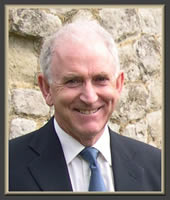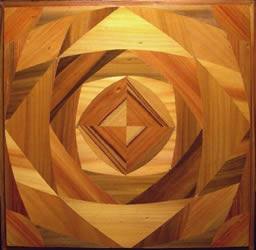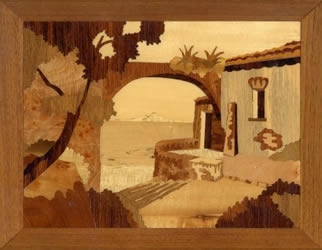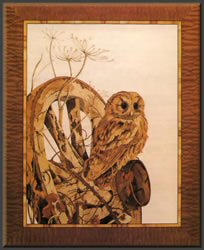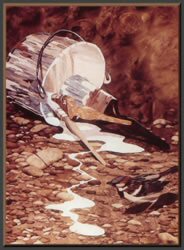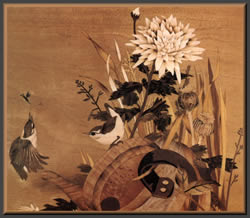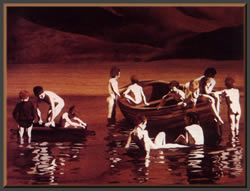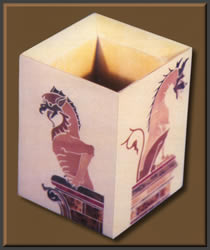|
 |
|
![]()
INTERVIEW NUMBER 1
|
|||||||||||||||
Peter is, currently, the Vice Chairman of the Society and Hon. Secretary of the Meopham Group situated in North Kent . He is 6l years old, married to Pat with a son and a daughter. Although he does not look old enough he also has a young 10 month old granddaughter.
C. Peter, how did you first get into marquetry? P. I invented it, or so I thought at the time. It must have been in the mid 70's and I had decorated our living room and one wall had been clad in pine (as was the fashion at the time). Not wanting traditional knotty pine I sought the advice of a local timber merchant and he came up with the idea of either cedar or parana pine. The cedar I found rather dark but some of the parana pine I was shown had interesting colours running through it. The supplier was prepared to select the most attractive planks for me, so this is what I ended up with. Not wanting to waste the off-cuts, I decided to shape them with a coping saw, clean them up and assemble them into a geometric picture that I had already sketched out. The result surprised me and it showed just how attractive pieces of wood could look when formed into patterns this way. C. What first attracted you to this craft? P. I had always admired marquetry that could be seen on furniture in antique shop windows and the occasional piece shown on television, but never considered that it was anything that could be done by anyone other than a professional. The first pictorial marquetry I came across was at the end of the 70's whilst on holiday in Italy . My wife and I had taken a trip to the isle of Capri and found a whole range of pieces in a souvenir centre. I bought a small picture of a local scene, as the rest was way out of my budget. I know that Sorrento and the surrounding area still produce much marquetry for tourists as well as supplying countries world wide with boxes, trays, games boards etc at very low prices. I've been told that children using the pad method of cutting are used to produce the work so cheaply. I got started on `proper' marquetry for myself when my wife bought me an Atlas Craft' kit, Christmas 1979. 1 had often commented on how much I liked the idea of making pictures with wood and wished I could do something like the Italian piece I had bought on that holiday. She obviously picked up on this and it's thanks to Pat that I got underway and now she lives with it for better or for worse! This was the "stick as you go" method of working using balsa cement and I followed this up with a few more kit sets and then graduated on to doing my own thing. I stayed with this method until discovering the far easier `window method' after joining Bexley Marquetry Group in the early 80's
C. Your work is very varied so do you have any particular preferences in designs and from where do you derive them? P. I have no one particular preference although others might be forgiven for thinking that I have a penchant for birds and wildlife. Looking back at the pictorial work I have done in the twenty five years I've been cutting, I suppose you will find a good number of birds but also buildings, oriental scenes, landscapes, Frank Sutcliffe and Jack Vettriano reproductions, floral motifs and a few novelty subjects. My applied work, which number some twenty or more pieces, have had all manner of subjects incorporated into the work. Where the piece has been a commission, the designs have sometimes been rather offbeat. You can imagine the difficulty in designing a display stand for a retired police officer's paraphernalia, including his wooden truncheon! Or what about a trophy for the Spinners, Dyers & Weavers Guild! Like most marquetarians, who are predominantly copyist like me, I find my source material in all sorts of places. Card shops, calendars, newspaper supplements, art books, advertisements, record covers, you name it - I've used it. I keep a folder marked `new designs' where I keep a collection of illustrations etc that maybe one day will see the light of day and get worked on. Some will think this is a bit of a luxury as many people tell me that they have great difficulty in finding suitable material. All I would suggest is to keep your eyes peeled and don't close your mind to any subject matter. You can get lucky and suddenly spot something on the off chance, as I was recently with a small birthday card found in a garden centre that almost shouted at me `must be done in marquetry'. That was a piece I titled `Watching The Game' which came up trumps at the 2004 National for me.
C. Why do you choose to do any particular piece of marquetry? Is it for yourself, a present, because it is a fascinating design or is it for the challenge? P. Up until now it's been a mixture of all those things. If I've found a design that I feel I've just got to do, I'll get stuck in straight away, because I'm keen to see how it will turn out. If I'm making something as a present, as for example the box I made for my daughter when she got married, then that will be time driven, but I will always design such projects to be a challenge as well as interesting to do. At Meopham we have a Christmas Competition, an idea stolen from Bexley Group. The idea is that a subject is drawn out of a hat somewhere around October time and members wishing to take part make their piece. Then all the entries are judged by members at the Christmas social. The dictates of this type of thing means you are steered towards doing something you would not normally choose to do. This can be a surprisingly good thing and it's fun. Commissions are a different matter but I am usually given a fairly free hand so I am constantly able to make all my own work interesting.
P. I've never been really satisfied with any of them. The day I think I've made something that can't be improved upon I'll give up. You have to strive.
C. Has there been any piece of work, made by any other member, which has left you thinking "I wish I had done that?" P. Probably too many to mention and, although I've never copied anyone else's work as a result, I have nonetheless pinched ideas and techniques and incorporated them into my work. If you must pin me down to one though, I guess it would be the late Charlie Good's Approaching Dawn' C. Which Rosebowl win gave you most satisfaction? P. Depends how you define satisfaction. If its the gloat factor' I suppose it was winning on Chelmsford's home turf and stopping Alan Townsend's run at the top with `Tawney At The Wheel'. It was also my last year with Bexley and it meant so much to all of us at that time. `Our Favourite Place' winning in 1995 at Great Yarmouth, was probably the most rewarding though, because it was not a typical Rosebowl type picture, if there is such a thing. I was personally very pleased with the picture as I managed to portray the light catching the figures as I had hoped. Taking top honours with it was a real bonus. Having a frame instead of the traditional border caused a bit of a stir, but it's funny how things become more accepted over time. Marquetry pictures are exactly that and if a frame suits the work in the same way it would a painting, a print, or photograph, then why not fit one? My third win at Stoke with `Watching Paint Dry' was perhaps almost as rewarding because so many people made a point of coming up to me with positive comments.
Marquetarians are without doubt craftsmen and the interpretation of a design in wood veneers is quite an art. It would be more of an art if the design was also an original idea or concept. To my mind, if you can positively communicate with another by exercising a skill demanding mind and imagination, then you can consider yourself an artist. Mind you, as one dry wit said to me when discussing Turner Prize entries, "if that's art, I'm glad to be called a craftsman"
C. The `for or against coloured wood' argument has gone on for years. What are your views on it?
C. On a slightly contentious note, do you think that there is any case for introducing any other media into marquetry, e.g. pyrography? P. If you look at the `Judges Rules and Guidelines' you will find the following statement: `Wood veneers, Mother of Pearl, Ivory, Precious Metals etc are all valid marquetry materials and are to be judged as such'. So there is already scope and Ben Bedford has been incorporating materials other than wood veneer into his work for many years now. I also spotted some good use of abalone shell in a couple of pieces at this year's National. It's all fine by me and of course goes back centuries. Is pyrography much different to scorching, which I use quite a lot? Perhaps not, but to me it's more like drawing on wood and doesn't look so much at home, so I have reservations about that. C. Do you have any other crafts, hobbies or interests, which share your available time? P. My main interests beyond marquetry include music, photography and fooling around on my PC. They are however all intertwined. I have gradually been rerecording my vinyl collection on to CD and all my old 6cm x 6cm transparencies are also going through the digitisation process. With various programmes I can `clean up' scratched records and often cram two LP's on to one eighty minute CD, allowing me to play some of my old favourites in the car at long last. I know you could do it with cassette tapes, but what I can do now gives far superior listening quality. With the old family photos it's so much more practical to make a Video CD photo album and watch them on the TV. Gone are the days of the projector & screen for me. You would imagine I afford little time to my family and home but everything seems to fit in nicely. But when my ten month old granddaughter comes around everything stops. I am also a lapsed musician but, having recently played a couple of reunion gigs with my old mates, I still feel the urge to get the old gut box' out of the loft and have a strum. Time permitting I'll probably do that one day if only to amuse granddaughter Lucy, when she's a little older. |
